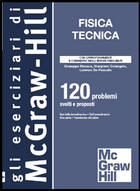T-Dynamics Exercise Book
Fisica Tecnica - 120 esercizi svolti e proposti
Giuseppe Starace, Gianpiero Colangelo, Lorenzo De Pascalis
ISBN: 9788838667916
Prezzo: Euro 14,00
Pubblicazione: marzo 2012
Pagg.352

|
During their educational time, students grow their understanding of engineering issues and techniques and learn the right approach to problems and solutions. It is during university time that professors should insist on saying to students that no separation exists between theoretical knowledge and the the application for solving design problems.
This text helps changing the widespread attitude of considering as distinct the practical skills from theoretical knowledge, proposing exercises with solutions that are easy to be seen as the natural consequence of what students have learned as general rules and principles typical of the Thermodynamics courses. The book helps to see that identifying a correct theoretical approach can easily be the basis of a succsessful solutions to problems and that the theoretical knowledge in itself, sometimes, rather than the rote application of often misunderstood formulas, provides the way for fast, full and exact solution or even solve the problem. With the obvious limitations of a workbook, this text propose at the beginning of each chapter, useful theoretical and never excessive (at least this was intended by the authors) information. Besides these hints, often special insights are provided that focus on aspects sometimes overlooked, just to highlight full continuity of the problems with the theory. In addition, in order to contribute to the students correct education, the workbook highlights the most common mistakes, showing the consequences to which each of them leads. The addressed subjects are:
The last chapter, which has the function of a compendium, offers more complex issues and problems that need to be solved of all the concepts discussed in previous chapters.
At the end of the workbook, an appendix is present with data, graphs and tables, which are useful and necessary for the solution of the proposed problems, which, far from being exhaustive of what provides the technical literature, also has the sense to bring students to the traditional use of graphical and tabular tools that makes them more involved in the physical meaning and behaviour of the thermodynamics systems. |
|
Durante le fasi dell’apprendimento si matura la sensibilità alle materie tecniche e se ne fa propria la mentalità. E' durante il periodo universitario che si deve insistere nella corretta impostazione e nella comprensione che non esista separazione tra conoscenze teoriche e le capacità di applicare per la risoluzione dei problemi progettuali.
Questo testo intende contribuire a mutare l'atteggiamento diffuso di separare le capacità pratiche dalle conoscenze teoriche alla loro base, proponendo esercizi per i quali è facile osservare quanto la loro soluzione sia la naturale conseguenza di quanto appreso in via generale, con l’approccio teorico della Fisica Tecnica. Vuole, cioè, dove possibile, evidenziare che l’approccio teorico è la base della soluzione del problema pratico e che la conoscenza teorica di per se stessa, talvolta, piuttosto che la pedissequa applicazione di formule mal comprese, fornisce la via per una veloce, piena ed esatta soluzione ovvero addirittura risolve il problema. Con le ovvie limitazioni di un eserciziario, questo testo pone all’inizio di ogni suo capitolo utili cenni teorici pertinenti e mai eccessivi (almeno nelle intenzioni degli autori). A questi fa seguire, con buona frequenza, approfondimenti che pongono l’attenzione su aspetti talvolta trascurati, proprio per fare risaltare la piena continuità dei problemi con la teoria. Ancora, per venire incontro alla corretta formazione dello studente, evidenzia gli errori più frequenti, mostrando le conseguenze a cui questi portano, Le materie affrontate sono:
In coda all’eserciziario, è presente un’appendice con dati, grafici e tabelle, utili e necessari allo svolgimento dei problemi proposti, che, lungi dall’essere esaustiva di quanto mette a disposizione la letteratura tecnica, ha anche il senso di richiamare all’uso tradizionale degli strumenti grafici e tabellari. |
